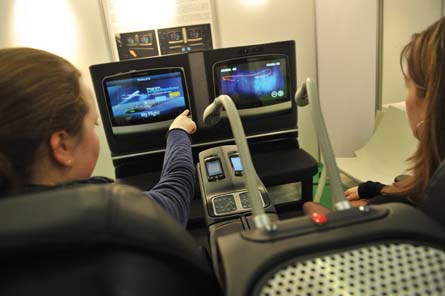In-flight entertainment (IFE) systems will soon do away with touchscreens and handsets if a prototype under development by Thales makes it through to production.
Looking like the webcam built into most of today's laptop screens, an infrared camera linked to the standard seatback screen is capable of reading a passenger's hand gestures to select IFE content and even control games. For passengers, the trick is to imagine a touchscreen hovering in mid-air at chest level.
Brett Bleacher, director of hardware advanced technologies at Thales Avionics in Irvine, California, says the goal is to enhance the IFE experience, so games will be developed to exploit the feel of the hand-gesture technology.
 |
|---|
| © Thales Hand gestures control Thales' Avant IFE system |
For airlines, the concept offers several key benefits, says Bleacher. First, touchscreens are expensive and suffer a lot of wear and tear, so a simple infrared camera - which in the future may be replaced by an even cheaper webcam - should cut costs. And as the entire IFE delivery system resides in the seatback installation, costs and overall maintenance are cut, and upgrades are simplified.
Another attraction is that aviation-grade seatback touchscreens are particularly expensive to certificate. Adhesives needed to laminate the control surfaces pose challenges around fire and head impacts.
Also, eliminating the touchscreen, or other manual controller, cuts the risk of disease transmission, which should make the technology attractive in other markets, ranging from medical applications to automated teller machines.
Gesture control is a fifth-generation feature for Thales' Avant system. The fourth generation, including Android-technology touchscreen handsets, will enter service in all classes on Qatar Airways Boeing 787s by year-end.
Bleacher says the gesture version, shown at a Thales technology exhibition in Paris in February and set to feature at the company's Hamburg interiors show display, is three years away from commercial readiness. But several airlines are showing interest, says Bleacher, and with a commitment, Thales could mobilise enough development resources to have the system flying in 18 months.
A sixth-generation system, he says, will go beyond hand gestures to use eyeball-tracking cameras for control. That technology already exists, but "we like to move forward in steps", he observes.
The selection of Android technology for handsets makes the Avant IFE system perform like the mobile smartphones with which so many customers are familiar. Using this open-source software platform also helps designers at Thales to devise IFE systems that are compatible with the personal handheld devices passengers increasingly expect to use on board aircraft.
The platform supports, for example, seat-to-seat communications, or even Skype conversations with people on the ground.
Source: Flight International























